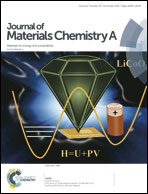Aqueous-processable polymer binder with strong mechanical and polysulfide-trapping properties for high performance of lithium–sulfur batteries†
Abstract
Lithium–sulfur batteries (LSBs) are regarded as the next-generation high-performance energy storage devices due to their high energy density. However, the long-term use of LSBs in practical applications is limited by the shuttle effect resulting from the diffusion of lithium polysulfides (LiPS) in electrolyte. To address these challenges, a novel aqueous-processable polymer with multiple functional groups, catechol-conjugated chitosan sulfate (CCS), is developed as the binder of the sulfur cathode. The CCS binder demonstrates strong adsorption capability to trap LiPS, as evidenced by ultraviolet-visible (UV-vis) spectra and density functional theory (DFT) calculations. Its excellent mechanical and binding properties also result in stabilization of sulfur cathodes in long-term cycling. LSBs assembled with CCS exhibit remarkable improvement in cycling performance with high capacity retention of 80.14% after 400 cycles at 0.5C, and the electrodes maintain their integrity without any clear cracks. At a high rate of 2C, the LSBs can still maintain 77.30% capacity after 300 cycles with high coulombic efficiency of 99.37%. Our results provide new insights into the significance of sulfate and catechol groups in CCS binder for sulfur cathode and pave a new way for the tailoring of the chemical structures of natural polymers to realize LSBs with superior electrochemical performance.



 Please wait while we load your content...
Please wait while we load your content...